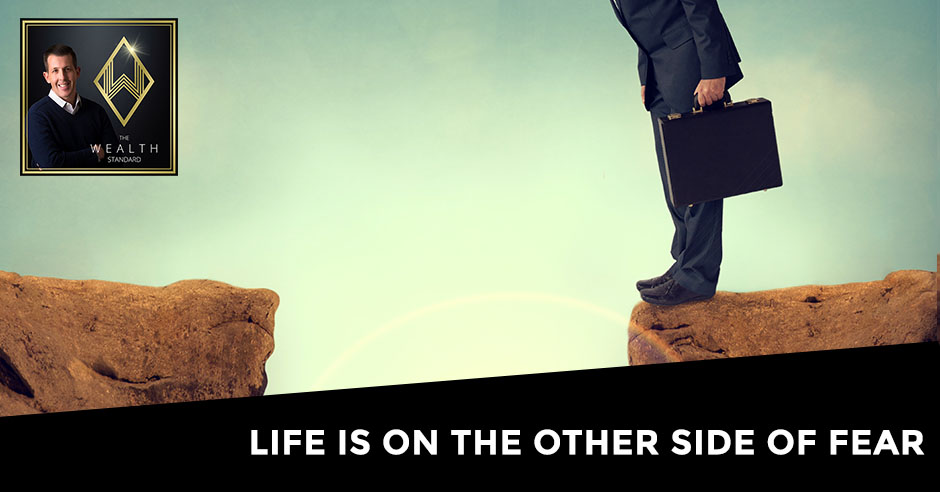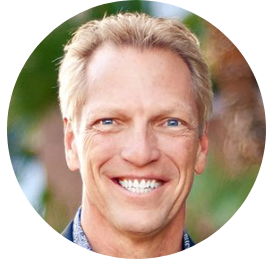Life Is On The Other Side Of Fear
Podcast: Play in new window | Download

How many times has fear held us up? How many opportunities did we miss just because we were too afraid to try? It is time to overcome that and start living life. As Patrick Donohoe highlights in this episode, life is on the other side of fear. He further elaborates that by pushing our fear thresholds, we realize that we can do more. Life demands growth, and if we hold ourselves back, we can’t possibly get to the life we are meant to live. Join Patrick in today’s show, where he shares his own experiences and lessons learned that you could apply in every aspect of life.
—
Watch the episode here:
Listen to the podcast here:
Life Is On The Other Side Of Fear
Everything you could possibly want out of life is on the other side of fear. I want to qualify that statement. I got some feedback that my head was in the cloud. I was not aware of what was going on in the world because of what I was choosing to focus the topics of this show on. I get it. I understand why someone would say something like that. There’s a lot going on. My intent is not to propagate ignorance. This show rarely, if ever, touches on circumstances and experiences that are outside of our control. In the Middle East, there’s always going to be conflict. There’s been for a long time. There are also things going on in government that are sad but that’s been the case for a long time. We don’t have control over monetary policy, fiscal policy, COVID. We don’t have control over policy.
We don’t have control over whether there’s quarantine or not. There are so many things that we think there’s a solution of control and influence and we get all worked up about it. I choose to focus on the things that I can’t control. The qualifier is everything that we could possibly want out of life is on the other side of the fear that we have control and influence over. In all aspects of life, there’s a gap between where we are now and where we want to be. Those are the two points. There’s a gap in between. That gap is laced, typically with some degree of fear. Fear of failure, success, pain, of what others will think of you if you succeed, of what others will think of you if you fail, and of what success or failure will mean to yourself image when you believe about yourself.
Life commands and demands growth. Click To TweetThe irony is that when we toe the line with this fear, there’s another fear that fills in the gap that takes its place. It’s a never-ending loop. An infinite loop. There are ways in which we can strategically push these thresholds. If we don’t, we are always going to come up against these thresholds because if you think about it, part of us tries to avoid fear and pain and rightfully so, at the same time, because life commands and demands growth. It will put things in our place over and over again, challenge, friction, pain, and problems so that we grow. Looking at what we can do to strategically position circumstances, experiences that will allow us to push those limits and thresholds, it could minimize or mitigate some of the challenges that often surprise us.
Early in my business career, I learned some invaluable lessons but it was at the cost of a lot of pain and failure I told you about. An investment failure that I had over ten years ago, but there were some relationship challenges that I had and they kept coming up over and over again. When I got out of the mess of 2008, 2009, 2010, I rebounded. I had a small team. I was doing pretty well, connected with the group and the group had another financial advisor that was working with them. I had a great relationship with this individual for a short period of time. Our wives are from the same country. We shared similar interests. We were very passionate about our principles, our values, and what we were doing financially.
We started working together and I saw some early signs. There were some red flags that came up regarding this individual’s desire to be independent beyond their own and not work with me in tandem. I did not feel the same way, but this individual did. I did not say anything. Red flags came up. I wanted to avoid conflict and build a relationship and it kept coming up over and over again. The final straw was this individual went to a group that we were working with and said, “I don’t think Patrick is necessary. I want to take over.” The group came to me and said, “This is what this person is saying. What do you think?” I was like, “I’m out.” It was too late. The relationship was ruined.
There were other circumstances after that with a team that I had built, at one point in 2014-ish, we had upwards of 70 employees. We were doing well and the wheels started to come off. There were people put in positions they shouldn’t have been in. There were those that had an illusion of experience and try to influence this area and that area. The conflict was a daily occurrence. I did not face that conflict. I did not know how to handle it. I kept pushing it off. What ended up happening is more of the same happened and ultimately, over the course of about twelve months, dozens of employees were either let go, fired or they’ve left on their own accord. It was insanely painful. I wanted to go back on my own. At the same time, I recognize the principle that life business was teaching me a lesson. I needed to learn that lesson.
What are the lessons you can gain from this? First off, again, nature is commanding growth in your life, your relationships, your finances, professionally, every area of your life. Physically, nature is compelling you to grow. Most people push off those signs. They don’t listen. They think that there’s an easier way, a shortcut and ultimately, what happens is a stronger experience then another strong experience. They keep stacking up until there’s a massive failure in pain. That’s when we decide to say, “This is a lesson. I need to make some changes. This is what I need to do.”
I’m going to go over two primary lessons you can take from this story. The first one is with regards to what I learned in any situation where another person is involved. I do not wait when a flag comes up. When a red flag occurs, I approach it head-on. Some of the things I say is I learned this from a therapist who specialized in businesspeople. I worked with her for over a year. She’s amazing. Karen Kindred, if you want to look her up, she has some podcast episodes and some interviews.
She taught me how to communicate with how I feel about certain things because you can’t argue with how somebody feels. It’s a way of feeling. I got to the point where these red flags came up. I said, “This is what is going on. This is how I feel. Please, help me understand your perspective.” That’s it. It’s very simple. You can use this in business and in your intimate relationships, your family relationships.
It helps you understand and share with and communicate with people at a deeper level. You either can gain perspective that you may not have had or their intention may be what you assumed and you know early on so you don’t have to prolong the inevitable, which will be even more painful if you continue to wait. I have an equation. When I feel something, see something that is irritating, that is frustrating, that borderline is like, “This is not right,” I approach it head-on. I share what I’m feeling. I share what my perspective is. In most circumstances, I’m not seeing things the same way as this other person. Them being able to express themselves helps resolve.
If the intention is what I assumed it was, I then escalate and say, “This is what I’m going to do next because this is how I feel. I don’t want it to go on any longer.” It points to a very quick conclusion that if a person does not want to essentially align with whatever the perspective and situation is, then there is a clear exit and it happens quickly. It’s so simple, but it’s been incredible. I’m going to give you the second lesson. I’m going to spend a little bit more time on this one, which is strategically designing a threshold by breaking through thresholds. Lesson two is you can strategically stretch yourself by pushing your own limits and learning to love challenges, friction, and conflict because you know that you can thrive because of being able to face it. Your psychological muscles continue to grow.

Other Side Of Fear: Find something you can do once a year that pushes these physical and psychological thresholds and builds your muscles, which ultimately allow you to face whatever challenges.
I believe your income, your wealth, what you can manage, whether it’s people or money, are correlated with this ability to handle conflict, friction, and challenge. There are some invaluable lessons that you’ll receive in this. Self-respect and self-competence are scraping the surface. Plus, being able to strategically position yourself in these areas will also allow you to grow at a much quicker pace. A few years ago, I saw this crazy guy speak at a Tony Robbins business event. His name was Jesse Itzler and he has this thing called a Big Ass Calendar. He says in a nutshell, “To do at least one crazy physical thing every single year.” Jesse pushes this to the limit. I’m not going to talk much about it.
I mentioned on the show before, but he wrote a book called Living with a SEAL, which is when he invited a Navy SEAL that he had met to live with them for a couple of months because he was so impressed by this individual’s ability to live a lifestyle at this very heightened level from an accountability perspective. He also wrote a book called Living with the Monks, where he spent a good amount of time living in a Monastery in, I believe, Upstate New York, again, to experience a very simple, basic lifestyle.
Jesse has a myriad of programs that he advocates. He does this thing called Hell on the Hill. He has a house in Connecticut where they have this big hill and run up a hundred times. He has the event every single year. He also has this event called Everesting. It’s done at about a dozen places around the country where you essentially hike up and down typically ski resort hills, the equivalent of the elevation of Mount Everest. You hike up, take a gondola down or a chairlift down, hike up again, typically over 36 hours. It is significant as far as elevation ends up being 25 miles-ish.
He does these events because he has connected this idea of pushing your physical and also mental thresholds strategically. What it does, it’s not just the physical aspect, you learn what you’re capable of. You push yourself to those limits that help your body, mind, and you realize that it can do hard things. It transits and builds muscles. I’m going to come back to the Everesting. There are other events, too. I’ve mentioned the Tony Robbins events, which are very psychological in nature that push you to these thresholds. An old business colleague of mine, Garrett White, has a program called Wake Up Warrior, which is primarily designed for men but pushes you to these psychological as well as physical limitations. A guest that I’m going to have on soon, Tim Reynolds. He has a course called Reclaim your Gladiator, where he does something similar. Mostly physical in nature at his ranch in Texas.
If you keep pushing these challenges off, life is going to put them in your path regardless. Click To TweetThere are so many different events like this, but the idea is to find something you can do once a year that pushes these physical and psychological thresholds and builds your muscles, which ultimately allow you to face whether they are challenges in marriage or friction in business. It allows you to face those and grow quickly from them instead of doing what I did, pushing them off. You attack it head-on because you understand the nature of the challenge, friction, and growth. The fact that if you keep pushing them off, life is going to put them in your path regardless. What I’m going to do soon, as you guys are reading to this episode, I am going to be going up this ski resort at Snowbasin. It’s in Eden, Utah, about an hour North of where I am in Salt Lake City. I’m going to be doing Everesting.
I’m going to be going up and down about 13, 14 times and I’m going to document it. I’m not going to document it to signal anything other than wanting to have you guys there as my accountability partner. I’m doing this by myself. There’s obviously a group doing it, but I’m not doing it with a friend, family member, a busy business colleague. I’m doing it by myself. I’m essentially going to be recording my thoughts, my experience, especially in those times of pain and difficulty. You are my audience and family and I want you to hold me accountable. I believe that these physical circumstances allow growth, not just in that specific category but in a lot of other aspects of life. I’ve done a couple of Tough Mudder and Spartan events. There are lots of these mud races, obstacle races, workout routines that allow you again to strategically position conflict, challenge, and friction in your life so that you are constantly growing.
—
Thank you for reading. I hope you learned something. Go out there, face some challenges, toe the line. You’ll be glad you did. Email me at Hello@TheWealthStandard.com. Tell me what you’re up to. Tell me what challenge you’re willing to face. Tell me what challenge you have faced in the past. I’d love to hear from you. If you want to adopt this Big Ass Calendar philosophy, psychology, go check out Jesse Itzler. He has a brand called Build Your Life Resume. Thanks for reading. We’ll talk to you next time. See you.
Important Links:
- Karen Kindred
- Big Ass Calendar
- Living with a SEAL
- Living with the Monks
- Hell on the Hill
- Everesting
- Wake Up Warrior
- Tim Reynolds
- Hello@TheWealthStandard.com
- Build Your Life Resume
Love the show? Subscribe, rate, review, and share!
















